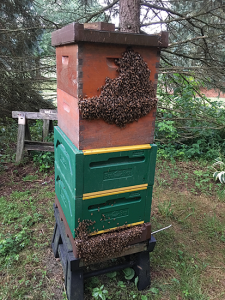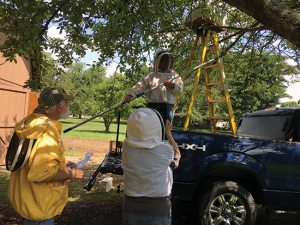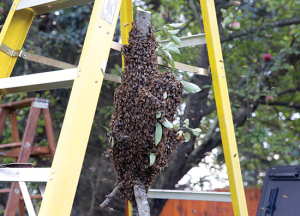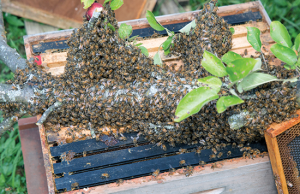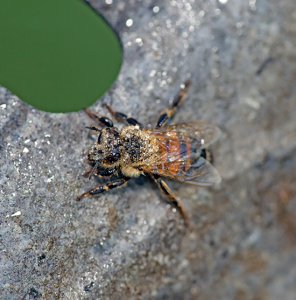By James E. Tew
The late Summer suicidal swarms of 2018
Late season swarms
No doubt, this saga is mostly – if not all – my fault. I was naïve last spring. Not that my innocence was special at that moment, for I have had many such episodes where “doing the right thing” ended somewhere totally different from what I had anticipated. I was trying to take care of my new packages in every way possible. The project wandered off toward right field.
Late last Winter
I had the now typical 30+% Winter-kill last Winter. No doubt I wrote about it. Messy job it is to clean that equipment. I accumulated some honey that was still consumable honey, but it was rough looking. I would not be eager to eat it, so I set it aside for a few weeks – saving it for bee packages and possibly other needy colonies. By the time the five packages came to me in late April, the honey was oozing here and there and then I really did not feel it was suitable for human consumption.
The packages
Who better to clean and refurbish this honey mess than the experts of honey production – honey bees. In fact, I was curious to know what the bees would do with this less-than-perfect honey. I briefly entertained the thought that they might even be able to recover it to an extractable condition. As this story ended, that didn’t happen. Much of it was consumed by the bees.
After I installed each package, I had the luxury of giving that new unit about 50-60 pounds of honey. Initially, I gave the new colonies pollen substitute, but that management need evaporated once natural pollen became available.
After a week or so, queens were out, and all looked good, so I let these new package colonies do their thing. A couple of weeks later, I had a look – smoke was not even needed – and straightaway found that all five packages had great brood patters and all looked good. This was beekeeping at its best. These new colonies, headed by new productive queens had little need of me. I added an occasional deep as needed.
They grew. They grew more. They were never hungry for a minute. They could produce all the healthy brood they wanted. Varroa populations were near nothing. No problem there. They grew more – even a lot more. They were big. By hot mid-Summer, they were bearding out front – especially during the evening hours. They were “fearsome” bee hives filled with huge bee populations. Clouds of foragers bearing pollen and nectar were returning en masse causing a frenzy at the entrance. What a truly great beekeeper I had proven to be. As Summer passed, the natural spring flow tapered to nearly nothing. Hot and dry.
Truth be told
Actually, I did not want the colonies to be this big. In what must now be hundreds of articles that involve my long-suffering neighbors, I just wanted medium-sized, healthy colonies. In previous rants, I have asked why bee colonies only come in one size – extra-large. Instinctually, it seems that most colonies desire to grow to an extra-large size so they can swarm all Summer; ergo, my neighbors are exposed to swarming bees on their property.
But here they were. Beautiful, large colonies that needed essentially nothing from me. I had grown colony monsters in my apiary. I was (and still am) responsible for them – not just biologically, but also managerially.
If I had a reason to open these colonies, I would have great numbers of bees all around the backyards. It would be hot, heavy work. Even so, I would clearly need to remove some of this honey. There was simply too much on the colonies.
The first swarm
Any beekeeper with just a short time under his/her bee belt could look at these colonies and tell they were of a swarming population. I just hoped they would not do it. It was very late for them to leave and find enough food reserves in NE Ohio. They were very likely to starve to death this Winter.
Bees are crazy smart – right? They can navigate with the sun. They can find water. They know to stay out of the rain (more about this later). They are simply biologically amazing. They will know that it is not instinctually smart to swarm in late Summer. That’s just bee logic.
They swarmed. They swarmed more. Yep, really smart bees they are.
It was a loud hummm…
It was the sound of Spring. I knew immediately what it was. My first angst was to determine which neighbor’s place it was going to land. In fact, it was landing about 18 feet up in my apple tree just outside my apiary fence. At least, it’s in my yard, but it certainly is higher than I would like. Bee adrenaline was immediately flowing. You know, I have decided that a bee swarm is a lot like an accident. You have a plan, you prepared, you’re good to go. Then, there is the swarm – everything you have planned is shot. Something like breaking your arm has a lot in common with a bee swarm. Whatever you were going to do, you are now going to do later.
The swarm was huge
This swarm may have been five-six pounds. I sense that by late October of this same year, it could easily grow to a seven pounder–in my mind. I went into the highest gear that I still have. It was hot and muggy. I was lifting and tugging. I needed trucks, ladders, boxes – I needed it all now. Of course, no help, but the neighbors were all watching.
Of course, it was high – maybe 18 feet. I used a 10’ ladder in the back of my truck, but for the first time in my aging life, I did not work off the ladder. I put a bait hive on top of the ladder and used an extension paint roller handle todislodge the swarm. It came crashing down but immediately went back to same spot. After multiple swarm shakes, the huge swarm began to cluster under the edge of my pickup truck bed. Finally, it went into the box I had there – but not happily.
Some points about this first swarm that were a bit different:
- Bees stung too much, so I ask you, if late Summer swarms – even fresh ones – are stingier than Spring swarms? We all know that Summer bees are testy bees.
- Bees were hard-headed. Maybe they already had a new site, but these bees really didn’t want my equipment. The equipment was from a dead out last Winter – possibly some dislike there.
- After they agreed to stay, they built up nicely but are now undergoing queen replacement. This swarm acts like it has all the time in the world.
The second swarm was just as large
You know the drill – drop everything – my bees are swarming. This one went at either a great time or a terrible time. Kim, Kathy, John (the coordinator in Kansas City) and I were conducting a live Kim and Jim show from my apiary. Kim and Kathy stood around – while John and the large audience watched from afar as I proceeded to dislodge the swarm from the ladder. As you know, I already had some experience with this procedure.
The bees did their thing time and again – right back to the same spot. I tried. I tried again. On maybe the fourth time, oh no, the swarm took flight – to my neighbor’s I suspected (yes, they were watching). The “show had to go on” but as we looked at bees and talked about packages, my heart and mind were on what I would have to do if they did go to someone else’s property.
Just as it was ending, my wife told me they had landed in a Hibiscus bush in our yard and that they were reasonably close to the ground. Great, great, great. We could handle that and we did. The bees seemed eager to occupy yet another winter-kill hive.
Some points about the second swarm:
- It was on the same limb as the first swarm. Swarms returning to the same spot does happen.
- It was another large swarm – much like before.
- I gave this swarm the last of my Winter-kill stores – maybe 40 pounds of honey.
- The next day, it had settled and was foraging as it should. I gently opened it, found the queen, and saw a small patch of eggs. Done and done.
- (Now jump ahead about three weeks). I needed an observation hive so I went to this colony. I was shocked to find that it was nearly starving – not quite, but near the edge. The colony had consumed ALL the stores trying to build up a large brood nest. Just as with swarm #1, this swarm colony was acting like it was early May.
Then the third swarm
For the first time in my bee life, the thought, “just let them go” flashed across my mind. I was officially tired of this abnormal behavior. I was low on both equipment and stores, but importantly, I had lost much of my interest in this procedure.
Of course, it was near the spot where the previous two swarms clustered – hardly six inches away.
Get the hive together, get the truck positioned, drag the heavy ladder into position, suit up, dislodge the swarm – all over again. This time, after more than an hour, this swarm would not come down. It went back to the same spot like visible bullets. I was exhausted.
Don’t ever do this. I told myself that day that I would not write it, but here it is. I have a pruning pole chainsaw. I could reach the limb without being very high on the ladder. The swarm was not worth it, but you know what I did. Indeed, I did get the limb down without incident. All the roving bees in the area came to the limb, now hanging on my ladder brace. It looked like I had them.
I moved the ladder in 10 to 12 foot jumps until I had the colony positioned in my apiary – Pied Piper as it were. The swarm moved in. I was totally burned out.
It was an overcast day. I spent several hours looking up at the swarm and hassling with it. I concentrated on nothing else. Later that evening – when my eyes were killing me – I realized that I should have worn sun shades. I had sunburned my eyes. I had messy eyes until late the next morning. Don’t ever do that.
I was out of honey for feed stocks. I gave them a couple of jars of granulated honey. The next day, I had a look for the queen. No sign. I have looked twice since then. The bees are strangely still and quiet on the comb, but absolutely no sign of a queen. I gave them a frame of brood. I realized they had to be fed.
Then the robbing started
I put on two top feeders on the last two swarms. One is queen-right and good-to-go but very little food and a significant brood nest. The last swarm was near starvation and seemingly queenless.
I spilled two dollops of thick sugar syrup on the landing board of the third swarm. I immediately knew that was not good. Random bees were flying everywhere. Before I could find an entrance reducer, the robbers were attacking. The hive is tight and the feeder does not leak, but that robbing behavior is relentless. Robbers are just crazy.
I can do nothing to help. If I open the sieged colony, I will immediately lose control. If I move it, the robbers will no doubt move to the next swarm – which is presently in good shape.
A managerial headache
This entire situation was caused by too many bees in colonies that are too large. My contention is that these huge swarms are little more than suicide swarms. They have little hope of establishing themselves before next Winter. But each of these swarms have (or did have) my package queens. Now I have three swarm colonies that will not survive if I do not provide necessary stores from the surplus honey the other colonies produced. Add to that, the three large colonies that cast the swarm, are now requeening themselves. Will they be successful?
If I open the large colonies to check their queen condition, I must contend with the robbing behavior in the yard. So I have tried to stabilize all the patients and allow them time to recover on their own – if they can. This is a managerial headache for me.
No science here, but I have made some observations from this ongoing experience.
- It is commonly said that bees are weather predictors. May I suggest that is a bit of Malarkey? One of the reasons I was pushing so hard with the third swarm was that a significant thunderstorm was pressing. It did happen. It rained one inch. This colony swarmed 2.5 hours before the rain came. I suspect that bees’ chitinous covering make them water resistant so they care little about rain or weather.
- I’m surprised at the number of swarm stragglers that stay at the original swarm site – for days. I mean, “go home.” Why are you still here. You’ve only been away from the parent hive a couple of hours. Now see #3.
- When the swarms naturally leave the original swarm site, they do it within minutes – I mean 100% gone in just a minute or so.
- These late Summer swarms stung considerably more than springtime swarms.
- These late Summer swarms consumed a prodigious amount of food stores in a short time.
- These late season swarms acted as though they were on the same schedule as in the Spring schedule. Superseding, foraging, brood production – really short on time for all of this activity. Yet, they seemed to try to stay on schedule.
As a beekeeper, I had to do something, but what? This has been a strange situation. Without me, these three swarms do not stand a chance of being here next Spring. In a natural world, these bees would have just died in the Winter. Do you suppose that the parent colony was balancing its bee population to better fit its natural cycle? I don’t know.
But I do clearly sense that all of these huge colonies casting late, huge swarms is not a good thing for my colonies at this time of the season. Of course, I will let you know what happens next.
Thanks, Jim
Dr. James E. Tew, State Specialist, Beekeeping, The Alabama Cooperative Extension System, Auburn University, Emeritus Faculty, Entomology, The Ohio State University; Tewbee2@gmail.com; http://www.onetew.com; One Tew Bee RSS Feed (www.onetew.com/feed/); http://www.facebook.com/tewbee2; @onetewbee





